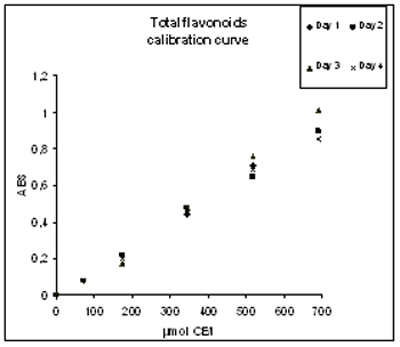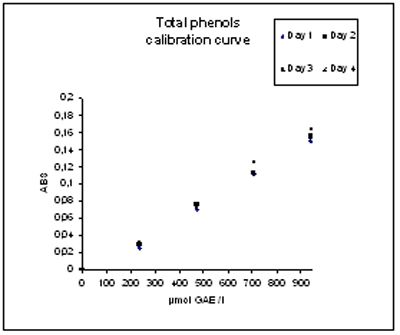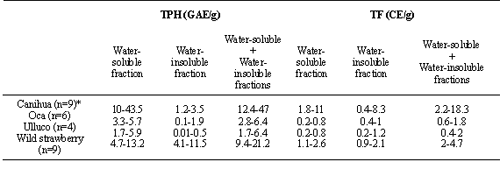Services on Demand
Journal
Article
Indicators
-
 Cited by SciELO
Cited by SciELO -
 Access statistics
Access statistics
Related links
-
 Similars in
SciELO
Similars in
SciELO  uBio
uBio
Share
Revista Boliviana de Química
On-line version ISSN 0250-5460
Rev. Bol. Quim vol.24 no.1 La Paz 2007
ARTICULO ORIGINAL
SPECTROPHOTOMETRIC METHODS FOR THE MEASUREMENT OF TOTAL PHENOLIC COMPOUNDS AND TOTAL FLAVONOIDS IN FOODS
J. Mauricio Peñarrieta abc, J. Antonio Alvaradoa*, Björn Bergenståhlc and Björn Åkessonb
Instituto de Investigaciones Químicas, Universidad Mayor de San Andrés, La Paz, Bolivia, Biomedical Nutrition, Pure and Applied Biochemistry, Lund University , Lund, Sweden, cFood Technology, Lund University, Lund, Sweden *Corresponding author: jaalvkir@gmail,com RESUMEN Como parte delestudio sobre el contenido de antioxidantes y compuestos fenólicos en alimentos de Bolivia fueron utilizados métodos simples para la determinación de compuestos fenólicos (TP) y flavonoides (TF) por espectrofotometría. Estos métodos son reportados en este artículo. Los métodos tuvieron alta reproducibilidad y correlación entre TP y TF para diferentes alimentos. Palabras clave: Alimentos Andinos, Compuestos bioactivos, antioxidantes, compuestos fenólicos totales (TPH), flavonoides totales (TF).ABSTRACT
As a part of a study on the content of antioxidants and phenolic compounds in Bolivian foods, several simple, rapid and selective methods for the determination of phenolic compounds (TPH) and flavonoids (TF) by spectrophotometry were used, which are described in this report. The methods had high reproducibility and there were high correlations between the values of TPH and TF in different plant foods Key words: Andean foods, bioactive compounds, antioxidants, total phenolics compounds (TPH), total flavonoids (TF).< Antioxidant constituents in plant material are of interest both to scientists and the public regarding their roles for human health (1). Phenolic compounds such a flavonoids and phenolic acids, are one of most important antioxidant food sources. Several flavonoid types are also the major red, blue and purple pigments in plants. Much information has been gained on the structures, chemical activities, and biosynthesis of these compounds (2). The flavonoids are a diverse family of aromatic molecules which are formed from phenylalanine and malonyl-coenzyme A. The flavonoids include six main subgrups in most plants: chalcones, flavones, flavonols, flavandiols, anthocyanins, and condensed tannins (or proanthocyanidins); a seventh subgroup, the aurones, has a lesser distribution. The antioxidative potential of flavonoids was one of the earliest functions proposed for these compounds, since they were found to stabilize foodstuffs by retardation of the development of rancidity and by extension of shelf-life.
The phenolic acids are present in plants and form a diverse group that includes the widely distributed hydroxybenzoic and hydroxycinnamic acids. The quantitative analysis of phenolic acids and flavonoids by measurement of ultra-violet absorption is well known (3). Other methods for their determination include HPLC, gas chromatography and mass spectrometry (4, 5, 6). The present work presents two different methods used for the quantification of flavonoids and phenolic substances in foods.
RESULTS AND DISCUSSION
Total phenolic compounds and total flavonoids
Both methods showed a good reproducibility regarding the calibration curves obtained on different days (Figures 1,2). The inter-day variation in data regarding the total phenolic content was less than 6 %,, while the variation in the total flavonoid content was less than 7%.
Content of total phenolic compounds and total flavonoids in different foods
Samples of different foods collected at altitudes from 2600 to 4000 meters above sea level were evaluated by measuring the content of total flavonoids and total phenolic compounds. The values obtained for the samples showed a good reproducibility between different days (the inter-day variation was less than 10%). The samples selected were canihua (Chenopodium pallidicaude), oca (Oxalis tuberosa), ullucu (Ollucus tuberosum) and wild strawberry (Fragaria vesca). The TPH and TF values in the water-soluble and water-insoluble fractions are shown in Table 1

Figure 1: Calibration curves obtained on different days for the measurement of total flavonoids expressed as catechin equivalents/L (CE).

Figure 2: Calibration curves obtained on different days for the measurement of total phenolic compounds expressed as gallic acid equivalents/L (GAE).
Only few data of the content of TPH in cereals and pseudo-cereals are available in literature and most of the information available concerns fruits and vegetables. The TPH values obtained in the present study were in general higher than the data obtained previously. For instance, the range of data found for canihua was higher than those obtained for sorghum (24.3 µmol GAE/g dw) (7) and buckwheat (18.8. µmol GAE/g dw) (8), a mean value for cereals (6.3 µmol/g dw) (9), and the value for sweet corn (3 µmol GAE/g fw) (10). In the present study the range of TPH determined in wild strawberry was 9.4 -21.2 µmol GAE/g fw expressed as the sum of the water-soluble and water-insoluble fractions. No previous data on the TPH content of wild strawberries are available in the literature. For comparison, the range reported for total phenolics of cultivated strawberries determined by the Folin–Ciocalteau assay was 6.2-19.4 µ mol GAE/g fw (10-15).
The data of TPH occurring in oca and ulluco obtained by the Folin–Ciocalteau assay were the lowest values found in the present study Regarding the occurrence of data on TF content in
the literature, only two publications were found about its content in cereals and fruits determined with the same method (8,11). The mean TF content of canihua samples expressed as the sum of water-soluble and water-insoluble values was higher than that in oat (0.6 µmol CE/g dw), amaranth (0.5 µmol CE/g dw) (8) and in sweet corn (0.2 µmol CE/g fw) (11). The high values of TF found in the canihua samples were probably accounted for by the amount of catechins in the samples. There are no available data about the content of TF in roots and tubers by use of the present methodology. In comparison with fruits and cereals, ulluco and oca showed lower values of TF. On the other hand, the mean TF content of wild strawberries samples reported in the present work expressed as the sum in the water-soluble and water-insoluble fractions were higher than those in strawberries (1.8 µmol CE/f dw) and in all of the fruits except the highest value obtained in plums (6.6 µmol CE/g fw) (11).

Figure 3. Relation between TF and TPH measurements in the water-soluble fraction of 29 food samples.
Correlation between TPH and TF values
Statistically significant correlations were observed between data obtained by the TF method versus those of the TPH method (both for the water–soluble fractions and water–insoluble fractions). For instance, in 29 samples of differents foods the TPH-TF correlation for the values of the water-soluble fraction was 0.85 (Figure 3) and for the values of the water-insoluble fraction it was 0.5. In conclusion, the present work describes two fast spectrophotometric methods for the quantification of flavonoids and phenolic substances in foods. They will be used in further studies of different raw and prepared foods and meals collected in Bolivia and other countries.
EXPERIMENTAL
Chemicals
The Folin-Ciocalteu reagent, gallic acid, sodium carbonate, sodium nitrite (99%), aluminium chloride hexahydrate (97%), acetone (p.a.) were purchased from Merck (Darmstadt, Germany), catechin (99%), aluminium chloride hexahydrate, sodium hydroxide, sodium nitrite were obtained from Sigma-Aldrich (St. Louis, USA), and acetic acid (glacial p.a.) and sodium acetate from BDH Chemicals Ltd. (Poole, UK).
Plant material
Nine samples of canihua (Chenopodium pallidicaule), nine samples of wild strawberry (Fragaria vesca), six samples of oca (Oxalis tuberosa) and four samples of ulluco (Ullucus tuberosus) were collected in April 2005 at altitudes ranging from 2600 to 4200 m above sea level from the Sorata valley and close to Titicaca Lake, Department of La Paz, Bolivia. The dry weight of the canihua samples was determined by drying them at 102°C over night.
Sample preparation
The fresh vegetable material was processed according to one of three alternatives. The semi-dry samples of canihua were extracted in 0.1 mol/l sodium acetate buffer (pH=5.0) by use of a liquid:sample ratio of 20:1 at room temperature. The roots ulluco and oca were extracted using a liquid:sample ratio of 7.5:1 and wild strawberries in a ratio of 1:1. After homogenisation in a mixer, the samples were centrifuged in a Thermo IEC Multi/RF with an 8850 rotor at 20000 g during 30 min at 4°C. The supernatant liquids were aspirated and stored at –80°C before being analyzed. One gram of the remaining pulp was homogenized with 8 ml of acetone and was stirred during 30 min at room temperature. Then the mixture was centrifuged for 10 min at 1200 g and room temperature. The supernatant solution was separated and stored at –80ºC before being analyzed (16).
Measurement of total phenolic compounds
The TPH was determined using the Folin-Ciocalteu reagent (a solution of phosphomolybdic and phosphotungstenic acids). The phenolic compounds are oxidized to phenolates by the reagent at alkaline pH in a saturated solution of sodium carbonate resulting in a blue molybdenum-tungsten complex (17). The Folin-Ciocalteu reagent, diluted 10 times (2.5 ml) and 2 ml of saturated sodium carbonate (75 g/L) and 50 µl of sample (diluted ten times) were mixed and homogenized for 10 s and heated for 30 min at 45ºC. The absorbance at 765 nm was read after cooling to room temperature. The absorbance of each sample was compared with those obtained from the standard curve made from gallic acid (235-1176 µmol/l). The data were expressed as µmol gallic acid equivalents per gram of fresh or dry (canihua samples) matter.
Measurement of total flavonoids
The total flavonoid content was determined according to Zhishen et al. (18). The sample was mixed with a reagent containing aluminium chloride and sodium nitrite, and a pink-colored flavonoid-aluminium complex was formed in alkaline medium. A solution corresponding to 30 µl of sodium nitrite (10%), 60 µl of aluminium chloride hexahydrate (20%), 200 µl of NaOH (1M) and 400 µl of water was added to 100 µl of each sample. The absorbance readings at 510 nm were started 5 min after the addition of the sample, and were performed every 20 s for 1 min. A reagent blank containing water instead of sample was used. The final absorbance of each sample was compared with a standard curve made from catechin (69-689 µmol/l). The data were expressed as µmol catechin equivalents per gram of fresh or dry (canihua samples) matter.
ACKNOWLEDGEMENTS
The study was supported by the Swedish International Development Agency (SIDA/SAREC) in a collaborative project between Universidad Mayor de San Andrés (Bolivia) and Lund University (Sweden). Additional support was provided by Lund University Hospital, the Påhlsson Foundation and the Swedish Research Council for Environment, Agricultural Sciences and Spatial Planning (FORMAS).

Table 1: Content of TPH (µmol gallic acid equivalents/g fresh and dry* matter) and TF (µmol catechin equivalents/g fresh and dry* matter) in extracts of different foods expressed as ranges.
REFERENCES
1. STEINMETZ, K.A., & POTTER, J.D. Vegetables, fruit and cancer prevention: A review. Journal of American Dietetic Association, 1996, 96, 1027-1039. [ Links ]
2. SHAHIDI, F. (CRC Press). Phenolics in food and nutraceuticals LLC 2004. [ Links ]
3. JURD, L., & GEISSMAO, T.A. Absorption spectra of metal complexes of flavonoid compounds. Journal of Organic Chemistry, 1956, 21, 1395-1401. [ Links ]
4. ANDLAUER, W., MARTENA, M.J., & FURST P., Determination of selected phytochemicals by reversed-phase high-performance liquid chromatography combined with ultraviolet and mass spectrometric detection. Journal of Chromatography A, 1999, 849, 341-348. [ Links ]
5. ANDLAUER, W., MARTENA, M.J., & FURST P., Determination of selected phytochemicals by reverse-phase high-performance liquid chromatography combined with ultraviolet and mass spectrometric detection. Journal of Chromatography A, 1999, 849, 341-348. [ Links ]
6. HARTLEY R.D., & BUCHAN, H., High-performance liquid chromatography of phenolic acids and aldehydes derived from plants or from the decomposition of organic matter in soil. Journal of Chromatography, 1979, 180, 139-143. [ Links ]
7. RAGAEE, S., EL-SAYED, M., ABDEL, A., & NOAMAN M., Antioxidant activity and nutrient composition of selected cereals for food use. Food Chemistry, 2006, 98, 32-38. [ Links ]
8. QUETTIER-DELAU, C., GRESSIER, B., VASSEUR, J., DINE, T., BRUNET, C., LUYCKX, M., CAZIN, M., CAZIN, J.C., BAILLEUL, F., & TROTIN, F., Phenolic compounds and antioxidant activities of buckwheat (Fagopyrum esculentum Moench) hulls and flour. Journal of Ethnopharmacology, 2000, 72, 35-42. [ Links ]
9. CZERWINSKI, J., BARTNIKOWSKA, E., LEONTOWICZ, H., LANGE, E., LEONTOWICZ, M., KATRICH, E., TRAKHTENBERG, S., & GORINSTEIN, S., (Avena sativa L.) and amaranth (Amaranthus hypochondriacus) meals positively affect plasma lipid profile in rats fed cholesterol-containing diets., Journal of Nutritional Biochemistry, 2004, 15, 622-629. [ Links ]
10. SAURA-CALIXTO, F. & GOÑI, I., Antioxidant capacity of the Spanish Mediterranean diet. Food Chemistry, 2006, 94, 442-447. [ Links ]
11. CHUN, O.K., KIM, D.O., SMITH, N., SCHROEDER, D., HAN, J.T., & LEE, C.Y. Daily consumption of phenolics and total antioxidant capacity from fruit and vegetables in the American diet. Journal of the Science of Food and Agriculture, 2005, 85, 1715-1724. [ Links ]
12. CHEEL, J., THEODULOZ, C., RODRIGUEZ, J.A., CALIGARI, P.D.S., & SCHMEDA-HIRSHMANN, G., Free radical scavenging activity and phenolic content in achenes and thalamus from Fragaria chiloensis ssp. chiloensis, F. vesca and F. ananassa cv. Chandler. Food Chemistry, 2007, 102, 36-44. [ Links ]
13. SCALZO, J., POLITI, A., PELLEGRINI, N., MEZZETTI, B., & BATTINO, M., Plant genotype affects total antioxidant capacity and phenolics content in fruit. Nutrition, 2005, 21, 201-213. [ Links ]
14. PROTEGGENTE, A.R., PANNALA, A.S., PAGANGA, G., VAN BUREN, L., WAGNER, E., WISEMAN, S., VAN DE PUT, F., DACOMBE, C., & RICE-EVANS, C., The antioxidant activity of regularly consumed fruit and vegetables reflects their phenolics and vitamin C composition. Free Radicals Research, 2002, 36, 217-233. [ Links ]
15. HEINONEN, M., MEYER, A.S., & FRANKEL, E.N., Antioxidant activity of berry phenolics on human low-density lipoprotein and liposome oxidation. Journal of Agricultural and Food Chemistry, 1998, 46, 4107-4112. [ Links ]
16. NILSSON, J., PILLAI, D., ÖNNING, G., PERSSON, C., NILSSON, Å. & ÅKESSON, B., Comparison of the ABTS and FRAP methods to assess the total antioxidant capacity in extracts of fruit and vegetables. Molecular Nutrition and Food Research, 2005, 49, 239-246. [ Links ]
17. SINGLETON, V.L., & ROSSI, J.A. Jr., Colorimetry of total phenolics with phosphomolybdic-phosphotungstic acid reagent. American Journal of Enology and Viticulture, 1965, 16, 144-158. [ Links ]
18. ZHISHEN, J., MENGCHENG, T., & JIANMING, W., Determination of flavonoid contents in mulberry and their scavenging effects on superoxide radicals. Food Chemistry, 1999, 64, 555-559. [ Links ]














